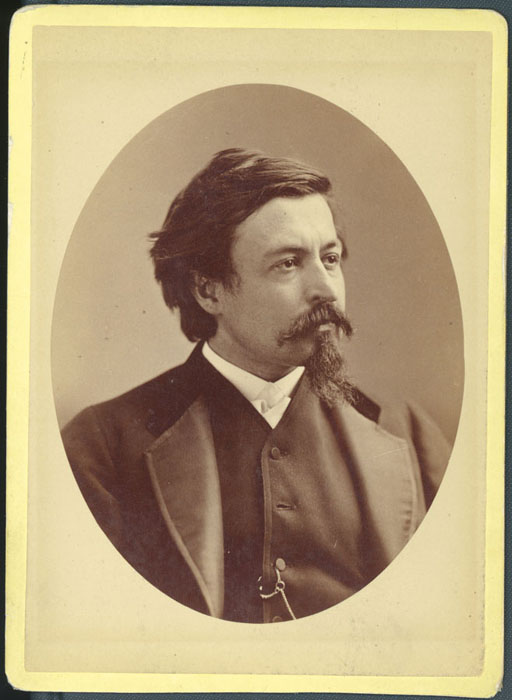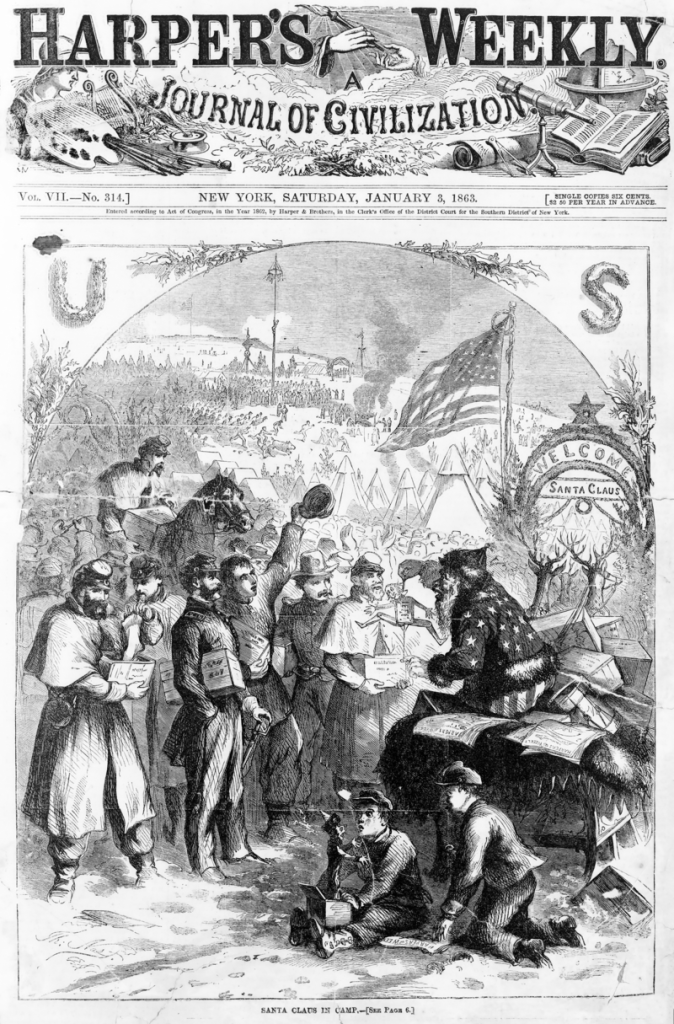 Thomas Nast (September 27, 1840 – December 7, 1902) was a German-born American caricaturist and editorial cartoonist considered to be the “Father of the American Cartoon” lived in Harlem, New York.
Thomas Nast (September 27, 1840 – December 7, 1902) was a German-born American caricaturist and editorial cartoonist considered to be the “Father of the American Cartoon” lived in Harlem, New York.
He was the scourge of Democratic Representative “Boss” Tweed and the Tammany Hall Democratic party political machine. Among his notable works were the creation of the modern version of Santa Claus and the political symbol of the elephant for the Republican Party. Contrary to popular belief, Nast did not create Uncle Sam (the male personification of the American people), Columbia (the female personification of American values), or the Democratic donkey, though he did popularize these symbols through his artwork. Nast was associated with the magazine Harper’s Weekly from 1859 to 1860 and from 1862 until 1886.
Albert Boime argues that:
-
As a political cartoonist, Thomas Nast wielded more influence than any other artist of the 19th century. He not only enthralled a vast audience with boldness and wit, but swayed it time and again to his personal position on the strength of his visual imagination. Both Lincoln and Grant acknowledged his effectiveness in their behalf, and as a crusading civil reformer he helped destroy the corrupt Tweed Ring that swindled New York City of millions of dollars. Indeed, his impact on American public life was formidable enough to profoundly affect the outcome of every presidential election during the period 1864 to 1884.
Nast was born in the barracks of Landau, Germany (now in Rhineland-Palatinate), the last child of Appolonia and Joseph Thomas Nast. He had a sister named Andie; two other siblings died before he was born. His father—a trombonist in the Bavarian 9th regiment band—held political convictions that put him at odds with the Bavarian government. In 1846, Joseph Nast left Landau, enlisting first on a French man-of-war and subsequently on an American ship. He sent his wife and children to Harlem, New York, and at the end of his enlistment in 1850 he joined them there.
Nast attended school, New York from the age of six to fourteen. He did poorly at his lessons, but his passion for drawing was apparent from an early age. In 1854 he was enrolled for about a year of study with Alfred Fredericks and Theodore Kaufmann, and then at the school of the National Academy of Design. In 1856, he started working as a draftsman for Frank Leslie’s Illustrated Newspaper. His drawings appeared for the first time in Harper’s Weekly on March 19, 1859, when he illustrated a report exposing police corruption.
The cover of the Nast’s Santa Claus on the cover of the January 3, 1863, issue of Harper’s Weekly:
 In February 1860, he went to England for the New York Illustrated News to depict one of the major sporting events of the era, the prize fight between the American John C. Heenanand the English Thomas Sayers sponsored by George Wilkes, publisher of Wilkes’ Spirit of the Times. A few months later, as artist for The Illustrated London News, he joinedGaribaldi in Italy. Nast’s cartoons and articles about the Garibaldi military campaign to unify Italy captured the popular imagination in the U.S. In February 1861, he arrived back in New York. In September of that year, he married Sarah Edwards, whom he had met two years earlier.
In February 1860, he went to England for the New York Illustrated News to depict one of the major sporting events of the era, the prize fight between the American John C. Heenanand the English Thomas Sayers sponsored by George Wilkes, publisher of Wilkes’ Spirit of the Times. A few months later, as artist for The Illustrated London News, he joinedGaribaldi in Italy. Nast’s cartoons and articles about the Garibaldi military campaign to unify Italy captured the popular imagination in the U.S. In February 1861, he arrived back in New York. In September of that year, he married Sarah Edwards, whom he had met two years earlier.
He left the New York Illustrated News to work again, briefly, for Frank Leslie’s Illustrated News. In 1862, he became a staff illustrator for Harper’s Weekly. In his first years withHarper’s, Nast became known especially for compositions that appealed to the sentiment of the viewer. An example is “Christmas Eve” (1862), in which a wreath frames a scene of a soldier’s praying wife and sleeping children at home; a second wreath frames the soldier seated by a campfire, gazing longingly at small pictures of his loved ones. One of his most celebrated cartoons was “Compromise with the South” (1864), directed against those in the North who opposed the prosecution of the American Civil War. He was known for drawing battlefields in border and southern states. These attracted great attention, and Nast was called by President Abraham Lincoln “our best recruiting sergeant”.
NYReligion reports that:
As he considered moving to Harlem to escape hostility from racists, the abolitionist Protestant cartoonist Thomas Nast provided some of the most famous editorial cartoons upholding the human dignity of African Americans against the claims of slavocrats. His relocation to Harlem in 1864 with its African American population and lingering Dutch traditions resonated in his work as a cartoonist.
After the war, Nast strongly opposed the Reconstruction policy of President Andrew Johnson, who he depicted in a series of trenchant cartoons that marked “Nast’s great beginning in the field of caricature”.
Nast’s cartoons frequently had numerous sidebars and panels with intricate subplots to the main cartoon. A Sunday feature could provide hours of entertainment and highlight social causes. After 1870, Nast favored simpler compositions featuring a strong central image.[6] He based his likenesses on photographs.
In the early part of his career, Nast used a brush and ink wash technique to draw tonal renderings onto the wood blocks that would be carved into printing blocks by staff engravers. The bold cross-hatching that characterized Nast’s mature style resulted from a change in his method that began with a cartoon of June 26, 1869, which Nast drew onto the wood block using a pencil, so that the engraver was guided by Nast’s linework. This change of style was influenced by the work of the English illustrator John Tenniel.
A recurring theme in Nast’s cartoons is racism and anti-Catholicism. Nast was baptized a Catholic at the Sankt Maria Catholic Church in Landau, and for a time received Catholic education in New York City. When Nast converted to Protestantism remains unclear, but his conversion was likely formalized upon his marriage in 1861. (The family were practicing Episcopalians at St. Peter’s in Morristown). Nast considered the Catholic Church as a threat to American values. According to his biographer, Fiona Deans Halloran, Nast was “intensely opposed to the encroachment of Catholic ideas into public education”.[20] When Tammany Hall proposed a new tax to support parochial Catholic schools, he was outraged. His savage 1871 cartoon “The American River Ganges,” shows portrayed Catholic bishops, guided by Rome, as crocodiles moving in to attack American school children As Irish politicians prevent their escape. He portrayed public support for religious education as a threat to democratic government. The authoritarian papacy in Rome, ignorant Irish Americans, and corrupt politicians at Tammany Hall figured prominently in his work. Nast favored nonsectarian public education that mitigated differences of religion and ethnicity. However, in 1871 Nast and Harper’s Weekly supported the Republican-dominated board of education in Long Island in requiring students to hear passages from the King James Bible, and his educational cartoons sought to raise anti-Catholic and anti-Irish fervor among Republicans and independents.
NYReligion continues:
By 1872 Harlem had grown to 50,000 people. African American church baptisms in the Harlem River became a common sight. Some downtown churches responded to the new influx by establishing new churches.
In 1869 evangelical leader S. H. Tyng of Trinity Church laid the cornerstone for Trinity Church in Harlem at Fifth Avenue and 125th Street. Nast lived next door to the church.
Nast expressed Anti-Irish sentiment by depicting them as violent drunks. He used Irish people as a symbol of mob violence, machine politics, and the exploitation of immigrants by political bosses. Nast’s emphasis on Irish violence may have originated in scenes he witnessed in his youth. Nast was physically small and had experienced bullying as a child. In the neighborhood where he grew up, acts of violence by the Irish against black Americans were commonplace.[24] In 1863, he witnessed the New York City draft riots in which a mob composed mainly of Irish immigrants burned the Colored Orphan Asylum to the ground. His experiences may explain his sympathy for black Americans and his “antipathy to what he perceived as the brutish, uncontrollable Irish thug”.
In general, his political cartoons supported American Indians and Chinese Americans. He advocated the abolition of slavery, opposed racial segregation, and deplored the violence of the Ku Klux Klan. One of his more famous cartoons, entitled “Worse than Slavery,” showed a despondent black family holding their dead child as a schoolhouse is destroyed by arson, as two members of the Ku Klux Klan and White League,paramilitary insurgent groups in the Reconstruction-era South, shake hands in their mutually destructive work against black Americans. Despite Nast’s championing of minorities, Morton Keller writes that later in his career “racist stereotypes of blacks began to appear: comparable to those of the Irish.”
Nast introduced into American cartoons the practice of modernizing scenes from Shakespeare for a political purpose.
Nast’s drawings were instrumental in the downfall of Boss Tweed, the powerful Tammany Hall leader. As commissioner of public works for New York City, Tweed led a ring that by 1870 had gained total control of the city’s government, and controlled “a working majority in the State Legislature”.[26] Tweed and his associates—Peter Barr Sweeny (park commissioner), Richard B. Connolly (controller of public expenditures), and Mayor A. Oakey Hall—defrauded the city of many millions of dollars by grossly inflating expenses paid to contractors connected to the Ring. Nast, whose cartoons attacking Tammany corruption had appeared occasionally since 1867, intensified his focus on the four principal players in 1870 and especially in 1871.
Tweed so feared Nast’s campaign that he sent an emissary to offer the artist a bribe of $100,000, which was represented as a gift from a group of wealthy benefactors to enable Nast to study art in Europe. Feigning interest, Nast negotiated for more before finally refusing an offer of $500,000 with the words, “Well, I don’t think I’ll do it. I made up my mind not long ago to put some of those fellows behind the bars”. Nast pressed his attack in the pages of Harper’s, and the Ring was removed from power in the election of November 7, 1871. Tweed was arrested in 1873 and convicted of fraud. When Tweed attempted to escape justice in December 1875 by fleeing to Cuba and from there to Spain, officials in Vigo, Spain, were able to identify the fugitive by using one of Nast’s cartoons.
Harper’s Weekly, and Nast, played an important role in the election of Ulysses Grant in 1868 and 1872; in the latter campaign, Nast’s ridicule of Horace Greeley’s candidacy was especially merciless.[30] After Grant’s victory in 1872, Mark Twain wrote the artist a letter saying: “Nast, you more than any other man have won a prodigious victory for Grant—I mean, rather, for Civilization and Progress.”[31] Nast became a close friend of President Grant and the two families shared regular dinners until Grant’s death in 1885.
Nast and his wife moved to Morristown, New Jersey in 1872 and there they raised a family that eventually numbered five children. In 1873, Nast toured the United States as a lecturer and a sketch-artist. His activity on the lecture circuit made him wealthy. Nast was for many years a staunch Republican. Nast opposed inflation of the currency, notably with his famous rag-baby cartoons, and he played an important part in securing Rutherford B. Hayes’ presidential election in 1876. Hayes later remarked that Nast was “the most powerful, single-handed aid [he] had”, but Nast quickly became disillusioned with President Hayes, whose policy of Southern pacification he opposed.
Between 1877 and 1884, Nast’s work appeared only sporadically in Harper’s. Although his sphere of influence was diminishing, from this period date many of his pro-Chinese immigration drawings; Nast was one of the few editorial artists who took up for the cause of the Chinese in America.
During the presidential election of 1880, Nast felt that he could not support the Republican candidate, James A. Garfield, because of Garfield’s involvement in the Crédit Mobilier scandal; and did not wish to attack the Democratic candidate, Winfield Scott Hancock, his personal friend and a Union general whose integrity commanded respect. As a result, “Nast’s commentary on the 1880 campaign lacked passion”, according to Halloran. He submitted no cartoons to Harper’s between the end of March 1883 and March 1, 1884, partly because of illness.
In 1884, Curtis and Nast agreed that they could not support the Republican candidate James G. Blaine, a proponent of high tariffs and the spoils system who they perceived as personally corrupt. Instead they became Mugwumps by supporting the Democratic candidate, Grover Cleveland, whose platform of civil service reform appealed to them. Nast’s cartoons helped Cleveland become the first Democrat to be elected President since 1856. In the words of the artist’s grandson, Thomas Nast St Hill, “it was generally conceded that Nast’s support won Cleveland the small margin by which he was elected. In this his last national political campaign, Nast had, in fact, ‘made a president.'”
Nast’s tenure at Harper’s Weekly ended with his Christmas illustration of December 1886. It was said by the journalist Henry Watterson that “in quitting Harper’s Weekly, Nast lost his forum: in losing him, Harper’s Weekly lost its political importance.” Fiona Deans Halloran says “the former is true to a certain extent, the latter unlikely.”
Nast lost most of his fortune in 1884, after investing in a banking and brokerage firm operated by the swindler Ferdinand Ward. In need of income, Nast returned to the lecture circuit in 1884 and 1887. Although these tours were successful, they were less remunerative than the lecture series of 1873.
In 1890, Nast published Thomas Nast’s Christmas Drawings for the Human Race. He contributed cartoons in various publications, notably the Illustrated American, but was unable to regain his earlier popularity. His mode of cartooning had come to be seen as outdated—a more relaxed style exemplified by the work of Joseph Keppler was in vogue. Health problems, which included pain in his hands which had troubled him since the 1870s, affected his ability to work.
In 1892, he took control of a failing magazine, the New York Gazette, and renamed it Nast’s Weekly. Now returned to the Republican fold, Nast used the Weekly as a vehicle for his cartoons supporting Benjamin Harrison for president. The magazine had little impact and ceased publication seven months after it began, shortly after Harrison’s defeat.
The failure of Nast’s Weekly left Nast with few financial resources. He received a few commissions for oil paintings, and drew book illustrations. In 1902, he applied for a job in the State Department, hoping to secure a consular position in western Europe. Although no such position was available, President Theodore Roosevelt was an admirer of the artist and offered him an appointment as the United States’ Consul General to Guayaquil, Ecuador in South America. Nast accepted the position and traveled to Ecuador on July 1, 1902. During a subsequent yellow fever outbreak, Nast remained on the job, helping numerous diplomatic missions and businesses escape the contagion. He contracted the disease and died on December 7 of that year. His body was returned to the United States, where he was interred in the Woodlawn Cemetery in The Bronx, New York.
Nast’s Santa Claus on the cover of the January 3, 1863, issue of Harper’s Weekly
Nast’s depiction of iconic characters, such as Santa Claus and Uncle Sam, are widely credited with giving us the recognized versions we see today.
In December 2011, a proposal to include Nast in the New Jersey Hall of Fame in 2012 caused controversy. The Wall Street Journal reported that because of his stereotypical cartoons of the Irish, a number of objections were raised about Nast’s work. For example, “The Usual Irish Way of Doing Things” portrays a sub-human Irishman as drunk and violent.
The Thomas Nast Award has been presented each year since 1968 by the Overseas Press Club to an editorial cartoonist for the “best cartoons on international affairs.” Past winners include Signe Wilkinson, Kevin (KAL) Kallaugher, Mike Peters, Clay Bennett, Mike Luckovich, Tom Toles, Herbert Block, Tony Auth, Jeff MacNelly, Dick Locher,Jim Morin, Warren King, Tom Darcy, and Don Wright.
The Thomas Nast Prize for editorial cartooning has been awarded by the Thomas Nast Foundation (located in Nast’s birthplace of Landau, Germany) since 1978. The prize is awarded periodically to one German cartoonist and one North American cartoonist. Winners receive 1,300 Euros, a trip to Landau, and the Thomas Nast medal. The American advisory committee includes Nast’s descendent Thomas Nast III of Fort Worth, Texas. Past winners of the Thomas Nast Prize include Jeff MacNelly, Jim Borgman, Paul Szep, Pat Oliphant, David Levine, Jim Morin, and Tony Auth.
A false urban legend states that the word “nasty” originated from Thomas Nast’s last name, due to the tone of his cartoons, but the word “nasty” has origins in Old French and Dutch hundreds of years before Nast was born.
Become a Harlem Insider!
By submitting this form, you are consenting to receive marketing emails from: Harlem World Magazine, 2521 1/2 west 42nd street, Los Angeles, CA, 90008, https://www.harlemworldmagazine.com. You can revoke your consent to receive emails at any time by using the SafeUnsubscribe® link, found at the bottom of every email. Emails are serviced by Constant Contact








